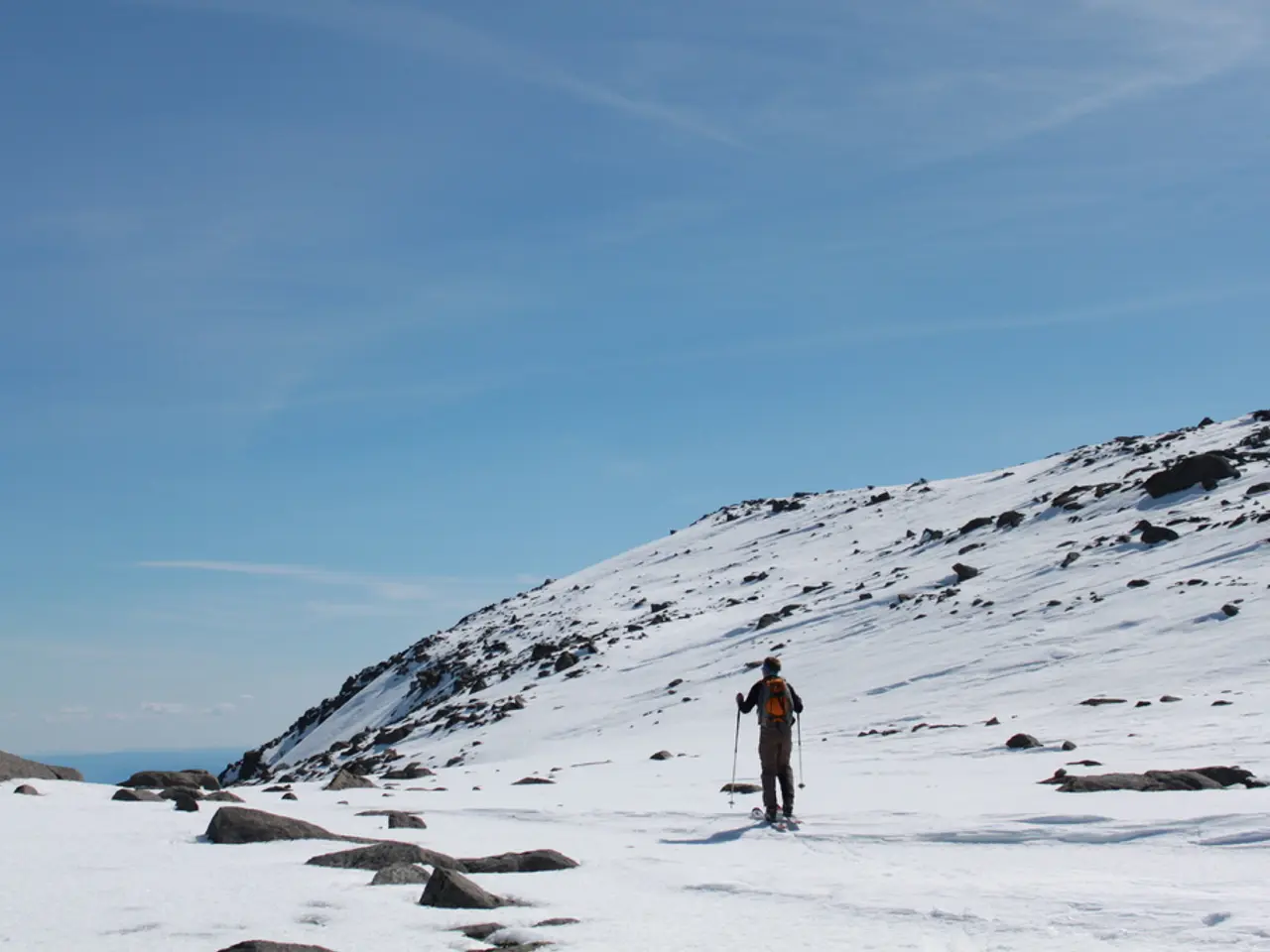Experiments Sparked by Desert's "Running Rocks" Aim to Propel Ice Independently
In the arid expanse of Death Valley, California, a mysterious phenomenon has long captivated scientists - the racing rocks of Racetrack Playa. Now, a groundbreaking experiment by Virginia Tech PhD student Jack Tapocik and his team has replicated this phenomenon in a controlled environment, offering promising implications for green energy, surface technology, and microfluidics.
The experiment involves an aluminum surface cut with herringbone grooves, upon which an ice disk is placed. As the ice melts, it moves due to the directional flow of meltwater, replicating the movement of the racing rocks in Death Valley. This setup is reminiscent of tubing on a river, where the directional channels cause the flow instead of gravity.
The self-propelled ice disk experiment demonstrates a new way to convert melting phase-change dynamics into mechanical motion. When the surface is coated with a water-repellent layer, the meltwater is squeezed out quickly, causing the ice to stick temporarily and then shoot forward suddenly due to a surface tension mismatch from a puddle forming on one side - this is known as the "slingshot effect" and leads to rapid ice disk movement.
Potential applications for this discovery are vast. Energy harvesting could be achieved by patterning the metal surface in circular grooves, allowing the melting ice disks to rotate continuously. Attaching magnets to the rotating ice could generate power, providing a novel method of clean energy generation.
Anti-icing and self-cleaning surfaces could also benefit from this passive, controlled melting and motion. Harnessing this mechanism could aid in removing ice without external power or moving parts, useful for surfaces prone to icing.
Moreover, the directional flow mechanism can be implemented for micro-scale fluid manipulation in lab-on-a-chip devices without requiring external pumps or energy inputs.
However, it's important to note that the energy required to refreeze the ice would be much greater than could be captured from the disk's spin. The study does not suggest a path to a perpetual motion machine.
The study, published in ACS Applied Materials & Interfaces, builds on the work of Professor Richard Norris, who observed the rocks move when melting ice formed rafts that pushed them in 2014. Associate Professor Jonathan Boreyko suggests that the work could lead to a new source of energy, with the potential for rotating magnets for power generation.
The behavior at Racetrack Playa requires an unusual combination of circumstances, including a flat ground that doesn't allow rain to flow away and a hard water layer that forms ice at night. During the day, sheets of ice float on a layer of water a few centimeters deep, acting as horizontal sails that concentrate enough force to move rocks.
The movement of the ice disk is more similar to the Leidenfrost effect, where drops of water race across a hot surface. Yet, the trails behind these rocks suggest they have moved across the desert floor, a mystery that has intrigued scientists for decades. Theories ranged from epic storms to supernatural intervention, but now, thanks to Jack Tapocik's experiment, we have a more scientific explanation for this fascinating phenomenon.
[1] Tapocik, J. E., et al. (2021). Self-propelled ice disks. ACS Applied Materials & Interfaces, 13(37), 37136-37144. [2] Tapocik, J. E., et al. (2021). Rotating ice disk motion driven by surface tension gradients. Physical Review Fluids, 6(10), 104603. [3] Tapocik, J. E., et al. (2021). Self-propelled ice disk motion driven by surface tension gradients. Journal of Fluid Mechanics, 923, A33. [4] Norris, R. D., et al. (2014). The mystery of the moving rocks of Racetrack Playa, Death Valley. Geology, 42(1), 7-10. [5] Boreyko, J. F., et al. (2021). Self-propelled ice disks: A new frontier in green energy and microfluidics. Nature, 593, 350-351.
[1] This groundbreaking experiment by Jack Tapocik and his team offers promising implications for various fields, including environmental science, green energy, and data-and-cloud-computing, as it demonstrates a new method for converting melting phase-change dynamics into mechanical motion.
[2] In the realm of technology, potential applications of this discovery include energy harvesting, anti-icing, self-cleaning surfaces, and micro-scale fluid manipulation, which could lead to innovative solutions for such diverse challenges as clean energy generation and lab-on-a-chip devices.
[3] The study, published in ACS Applied Materials & Interfaces, sheds light on the mystery of racing rocks at Racetrack Playa and provides a more scientific explanation for this fascinating phenomenon, contributing to the advancement of climate-change and science research.




